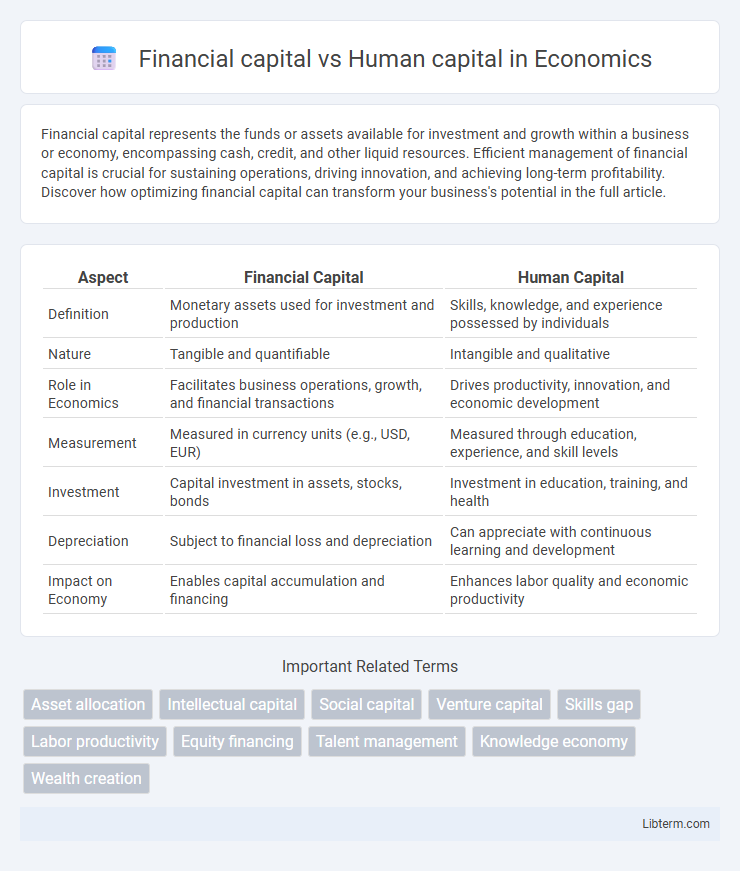Financial capital represents the funds or assets available for investment and growth within a business or economy, encompassing cash, credit, and other liquid resources. Efficient management of financial capital is crucial for sustaining operations, driving innovation, and achieving long-term profitability. Discover how optimizing financial capital can transform your business's potential in the full article.
Table of Comparison
| Aspect | Financial Capital | Human Capital |
|---|---|---|
| Definition | Monetary assets used for investment and production | Skills, knowledge, and experience possessed by individuals |
| Nature | Tangible and quantifiable | Intangible and qualitative |
| Role in Economics | Facilitates business operations, growth, and financial transactions | Drives productivity, innovation, and economic development |
| Measurement | Measured in currency units (e.g., USD, EUR) | Measured through education, experience, and skill levels |
| Investment | Capital investment in assets, stocks, bonds | Investment in education, training, and health |
| Depreciation | Subject to financial loss and depreciation | Can appreciate with continuous learning and development |
| Impact on Economy | Enables capital accumulation and financing | Enhances labor quality and economic productivity |
Introduction to Financial Capital and Human Capital
Financial capital refers to the funds or assets used by businesses and individuals to invest, operate, and generate economic value, typically encompassing money, credit, and other financial instruments. Human capital signifies the collective skills, knowledge, experience, and abilities possessed by individuals, which contribute to their productivity and economic potential. Both types of capital are critical assets driving organizational growth, with financial capital enabling resource acquisition and human capital fueling innovation and efficiency.
Defining Financial Capital
Financial capital refers to the monetary resources available to individuals or organizations for investment, operational expenses, and growth opportunities. It includes cash, credit, and other liquid assets that can be deployed to acquire goods, services, or technology. Unlike human capital, which encompasses skills, knowledge, and experience, financial capital is tangible and directly impacts the capacity to fund projects and expand business ventures.
Defining Human Capital
Human capital refers to the knowledge, skills, experiences, and health attributes possessed by individuals that enhance their productivity and economic value. Unlike financial capital, which encompasses monetary assets and investments, human capital represents the intangible resources inherent in people that drive innovation, efficiency, and growth within an organization or economy. Investing in education, training, and healthcare directly increases human capital, resulting in improved workforce capabilities and long-term economic benefits.
Key Differences Between Financial and Human Capital
Financial capital refers to the monetary resources available for investment, business operations, and wealth generation, while human capital encompasses the skills, knowledge, and experience possessed by individuals that contribute to productivity and innovation. Unlike financial capital, human capital is intangible and grows through education, training, and health improvements, making it a dynamic asset crucial for sustainable economic growth. Financial capital is quantifiable and can be transferred or depleted, whereas human capital accumulates over time and directly influences competitive advantage and organizational success.
The Role of Financial Capital in Business Growth
Financial capital provides the essential resources for business expansion, enabling investments in technology, infrastructure, and market development to increase operational capacity and revenue streams. Access to sufficient financial capital facilitates scaling production, hiring skilled employees, and enhancing marketing efforts, directly impacting competitive advantage. Efficient allocation of financial capital accelerates innovation and strategic initiatives, driving sustainable growth and long-term profitability.
The Impact of Human Capital on Organizational Success
Human capital significantly drives organizational success by enhancing innovation, productivity, and competitive advantage through skilled and motivated employees. Unlike financial capital, which is limited to monetary resources, human capital encompasses knowledge, experience, and creativity essential for sustainable growth. Organizations investing in employee development and training often achieve higher profitability and long-term resilience.
Measuring Financial Capital vs Human Capital
Measuring financial capital involves quantifying assets such as cash, investments, and physical properties using standardized financial statements and market valuations. Human capital measurement focuses on assessing skills, education, experience, and productivity through indicators like employee performance, training metrics, and knowledge capital assessments. While financial capital is evaluated through tangible monetary values, human capital relies on qualitative and quantitative analyses of workforce capabilities and intellectual contributions.
Strategies to Enhance Financial Capital
Investing in diversified portfolios and leveraging market opportunities are key strategies to enhance financial capital, ensuring steady growth and risk management. Implementing robust financial planning, including budgeting, saving, and debt management, optimizes asset accumulation and cash flow stability. Utilizing technology-driven tools for real-time financial analysis and decision-making can further maximize returns and capital efficiency.
Approaches to Develop Human Capital
Investing in education and continuous professional training enhances human capital by improving skills, knowledge, and productivity within the workforce. Implementing mentorship programs and fostering a culture of innovation encourage experiential learning and collaboration, driving personal and organizational growth. Utilizing technology-driven platforms for personalized learning accelerates skill acquisition and adapts to evolving industry demands.
Balancing Financial and Human Capital for Sustainable Growth
Sustainable growth requires a strategic balance between financial capital, which fuels investments and operational capabilities, and human capital, encompassing employee skills, creativity, and well-being. Companies that invest in workforce development and leverage talent management alongside robust financial planning achieve higher innovation, productivity, and long-term competitive advantage. Integrating metrics that track both financial performance and employee engagement ensures informed decision-making that supports continuous growth and resilience.
Financial capital Infographic

 libterm.com
libterm.com